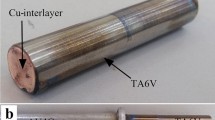Abstract
Au–Al intermetallic compounds (IMCs) were conventionally regarded as damage sources within wire bonding interfaces. Among the Au–Al IMCs system, Au2Al and AuAl2 IMCs were commonly observed after long-term service. Here, the intrinsic mechanical properties of Au2Al and AuAl2 IMCs were investigated by in-situ bending tests. The results clearly revealed that the transition from brittle to ductile facture behavior was determined by the atomic ratio of Au and Al elements, while Al-rich Au–Al IMC exhibits higher bending strength than that of Au-rich Au–Al IMC. The Al-rich Au–Al IMC such as AuAl2 indeed showed brittle fracture behavior, in which cracks propagated through the grain boundaries. In contrast, the Au-rich Au–Al IMC such as Au2Al appeared to be quite ductile and crack resistant, and its plastic deformation was undertaken by slip bands. This work suggested that not all Au–Al IMCs cause brittleness and lead to damages, only Al-rich IMCs should be avoided at wire bonding interfaces.





Similar content being viewed by others
References
C.L. Gan, U. Hashim, J. Mater. Sci. Mater. Electron. 26, 4412 (2015)
C. Breach, Gold Bull. 43, 150 (2010)
H. Xu, C. Liu, V.V. Silberschmidt, S. Pramana, T.J. White, Z. Chen, M. Sivakumar, V. Acoff, J. Appl. Phys. 108, 113517 (2010)
X. Zhang, T.Y. Tee, Thin Solid Films 504, 355 (2006)
C.D. Breach, F. Wulff, C.W. Tok, Microelectron. Reliab. 46, 543 (2006)
J. Watson, G. Castro, J. Mater. Sci. Mater. Electron. 26, 9226 (2015)
A. Surendar, V. Samavatian, A. Maseleno, A.Z. Ibatova, M. Samavatian, J. Mater. Sci. Mater. Electron. 29, 15249 (2018)
W.H. Chen, H.C. Cheng, C.F. Yu, J. Alloy. Compd. 689, 857 (2016)
H. Xu, C. Liu, V.V. Silberschmidt, S.S. Pramana, T.J. White, Z. Chen, V.L. Acoff, Intermetallics 19, 1808 (2011)
W.-H. Chen, C.-F. Yu, K.-N. Chiang, H.-C. Cheng, Intermetallics 62, 60 (2015)
H. Ji, M. Li, C. Wang, H.S. Bang, H.S. Bang, Mater. Sci. Eng. A 447, 111 (2007)
A. Furrer, M. Seita, R. Spolenak, Acta Mater. 61, 2874 (2013)
C. Xu, T. Sritharan, S. Mhaisalkar, Scr. Mater. 56, 549 (2007)
C.D. Breach, F. Wulff, Microelectron. Reliab. 44, 973 (2004)
H. Zhang, K.W. Siu, W. Liao, Q. Wang, Y. Yang, Y. Lu, Mater. Res. Express 3, 094002 (2016)
J. Lubliner, P. Papadopoulos, Introduction to Solid Mechanics (Springer, Cham, 2017), p. 353
H.Y. Wu, Y.H. Chen, C.R. Deng, X.F. Su, J. Alloys Compd. 528, 115 (2012)
T. Takasugi, E. George, D. Pope, O. Izumi, Scr. Metall. 19, 551 (1985)
H. Xu, I. Qin, H. Clauberg, B. Chylak, V.L. Acoff, Acta Mater. 61, 79 (2013)
Acknowledgements
This work was financially supported by the National Key R&D Program of China (Project No. 2017YFA0204403), the Shenzhen Virtual University Park (R-IND1710) and the Innovation and Technology Commission via the Hong Kong Branch of National Precious Metals Material Engineering Research Center. Part of the work described in this paper was supported by the Research Grants Council of the Hong Kong Special Administrative Region, China (No. CityU 11209914 and 11247516). This work was also supported by Province-Institute/Province-College Cooperation Project under Grant No. 2017IB016. The financial support from SZSTI (Ref: JSGG20141020103826038) is gratefully acknowledged by authors. Thanks Hong Kong Branch of National Precious Metals Material Engineering Research Centre for providing financial support. Thanks Dr. J. H. Luan for APT experiment help.
Author information
Authors and Affiliations
Corresponding authors
Ethics declarations
Conflict of interest
The authors do not have any possible conflicts of interest.
Rights and permissions
About this article
Cite this article
Yang, H., Cao, K., Zhao, X. et al. Brittle-to-ductile transition of Au2Al and AuAl2 intermetallic compounds in wire bonding. J Mater Sci: Mater Electron 30, 862–866 (2019). https://doi.org/10.1007/s10854-018-0357-6
Received:
Accepted:
Published:
Issue Date:
DOI: https://doi.org/10.1007/s10854-018-0357-6




